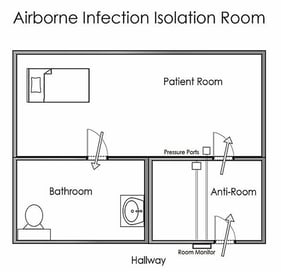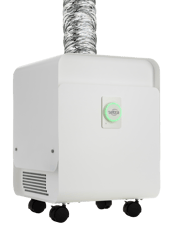Throughout the COVID-19 pandemic, healthcare facilities have needed to rapidly expand their isolation room capacity, since the safest way to handle the virus is to quarantine it in an isolation room. As such, the Airborne Infection Isolation Room has been a key aspect of COVID-19 responses across hospitals and healthcare systems.
What are Isolation Rooms?
Airborne Infection Isolation Rooms (AIIRs) are single occupant hospital rooms designed to prevent the spread of contagious disease using negative pressure. The negative air pressure pulls clean air into the room, keeps the air inside the isolation space, and prevents pathogens from escaping into surrounding areas. The contaminated air in the isolation space is them exhausted outside instead of recirculated through the main HVAC system.
Traditionally, isolation rooms are set up via manipulation of a building’s HVAC system to control the airflow. Applications outside of hospitals are not typically built with HVAC systems that can easily create negative pressure isolation spaces; changing a room to a traditional isolation room involves lengthy and expensive HVAC construction. During the COVID-19 pandemic, increasing the number of isolation rooms has not been a typical expansion for many facilities, but rather a quick adjustment to handle the increase in cases.
Method 1: Portable Fan System
One common method of creating additional temporary isolation rooms is to employ a portable fan system with a HEPA filter. Around the patient’s bed, a curtain is hung to create a boundary from the rest of the room. The fan and filter are positioned between the curtain and the rest of the room. Contaminated air is pulled through the filter before being exhausted into the rest of the room. To maintain this negative pressure, the area inside the curtain barrier should not have recirculating HVAC returns. A fan and filter system should create at least 12 air changes per hour (ACH), which is equivalent to a traditional isolation room.
Method 2: Setra AIIR Watch
A second effective method to create additional isolation rooms in spaces not originally designed for isolation without expensive retrofit construction is to use Setra AIIR Watch. Compact and mobile, Setra AIIR Watch can easily be used in any wing to create a temporary isolation room for any contagious disease. Once in a space, AIIR Watch immediately begins creating negative pressure to prevent contaminated air from escaping into hallways, common areas, and other patient rooms. With onboard HEPA filter and UVC light, contaminated air is sterilized on the first pass to create the safest possible exhaust. A flow rate of 375CFM means the AIIR watch can turn the air in a most patient rooms 12 or more times per hour.



